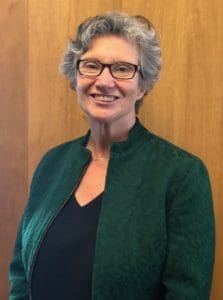By Linda Jackson
AAI Program Director
One night in my second story stucco apartment in a small Andean village, a sharp and long rolling earthquake jolted me awake. As a California girl, I knew what to do: I slipped on my shoes (shaking them out to make sure there were no hiding scorpions, per Peace Corps advice) and sweater, always by my bed, and dashed to the threshold at the front door. When the earth settled down, I went outside to check on my neighbors, an older couple who ran a tiny store where I bought my breakfast every day. Thankfully they were OK.
Turned out everyone had gone outside. The electricity was out, so it was a lovely darkness with moonlight revealing groups of people talking. We gravitated to the largest store in town, bright on the plaza thanks to the dueña’s generator. As humans have done for millenia, we gathered and waited for the second earthquake (“Don’t go back inside yet!”), and to ask each other for news of friends and neighbors. It was hours before people made their way back to their homes.
After that night, at every Amas de Casa meeting (weekly health classes that I taught in neighboring villages) over the next few weeks, women shared stories about where they were, how they took care of their families, and what they knew of this and past earthquakes.
I was just five months into my Peace Corps service in the midst of an eyes-wide-open view of the human experience shared after a disaster. We gather, build a shared recollection of what happened, learn something more about what to do next time, and resume our lives. In my little corner of the world, buses started running again, the electricity came back on, and life resumed its daily rhythm. It wasn’t until much later that I learned that the 8.2 earthquake that day, and the tsunami it triggered, killed more than 500 people.
Fast forward a few decades to Northern California. The emergency this time came with advanced notice from PG&E about a shutdown of electrical power. Those privileged enough to have generators had power, but for most there was no medical support, no light, no way to contact family or friends, no news, and no coffee.
In the AAI network, everyone from public agencies from the County to the smallest local agency stepped up to conduct their emergency operations responsibilities. Healthcare personnel provided medical alerts with advice and information about assistance, and checked in on patients about their well-being. Nonprofits checked in on their clients to make sure they had what they needed. Local community leaders from the Commission on Aging, Age-Friendly Planning, and Marin Villages shared official updates with their networks and visited local residential communities. Senior residential care facilities opened their doors to evacuees from Sonoma.
Ever since the power came back on, we have been sharing our experiences. For the last couple of weeks, meetings began with a debrief of who did what. We are also sharing ideas of what we can do differently and better next time.
As we look ahead to the next few years while the power grid’s maintenance is restored so that these days of shutdowns are a memory, there will be other emergencies and disasters. One of the greatest challenges remains how to contact and connect with our clients and colleagues when we don’t have electricity, internet, or cell phone service. We have to figure this out, because, as we saw in New Orleans in 2009 and now in Marin, being disconnected and alone are profound equity issues.
Here are three suggestions:
- If you are a community-based organization, sign up to be part of VOAD (Voluntary Organizations Active in Disaster). VOAD is a collaboration of non-profit, faith-based, community, and government agencies who work together to communicate, coordinate, and collaborate in a disaster. As we look ahead to how we can better respond to our clients, colleagues, and neighbors, we are fortunate to have this recently resurrected emergency preparedness network. This newsletter will share VOAD findings and recommendations as they emerge so you can upgrade your agency’s preparedness and response.
To join the VOAD network and participate in building the capacity of community-based organizations in responding in a disaster, contact Adriana Rabkin at marinvoad@gmail.com.
- Share the Commission of Aging’s Older Adult Housing in Marin report. We learned that there are independent senior residential communities where older people did not have the contact needed to ensure their well-being during the shutdown. The report’s Appendix A is an inventory of housing for older adults by jurisdiction. For agencies, community-based groups and healthcare workers, the report is an invaluable resource to identify where older people live in our cities and towns.
- Prepare for the next time. There are a myriad of resources for you personally and for your agency. Here are two:
– Emergency preparedness from the Marin County Sheriff’s Office
– Advice and events from Ready Marin
In the end, what matters most? During the PG&E power shutdown, many of us found a respite from the screen. We had instead real-time face-time connections with our family, neighbors, colleagues and clients. This is described eloquently in these reflections from Marin IJ columnist Vicki Larsen.
Earthquakes and other natural disasters, power shutdowns, and other man-made disasters — these events are reminders of what is most important in our lives and on this earth. May you have a happy Thanksgiving ~


